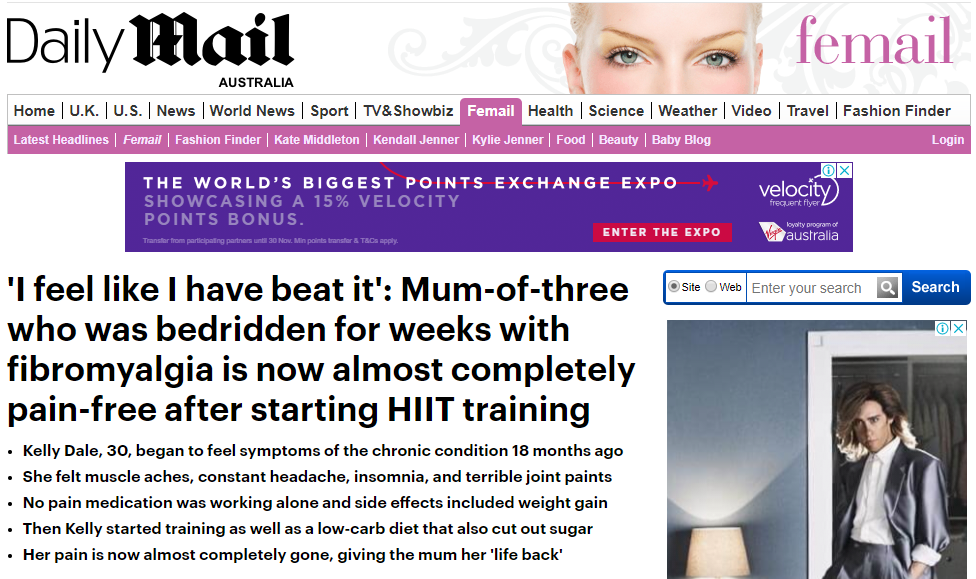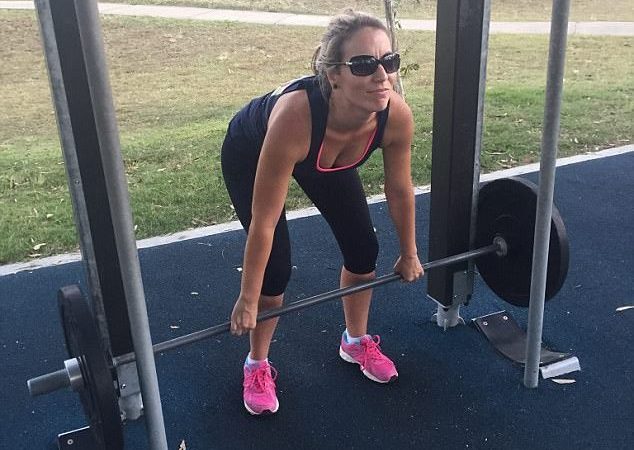Client: Naomi Ferstera, Exercise Physiologist

A Queensland mum has got her life back after HIIT training finally helped with the fibromyalgia that had left her in constant pain for months.
Kelly Dale, 30, first began to feel the symptoms of the chronic condition – which causes pain in the muscles and bones – 18 months ago.
The mum-of-three had just recovered from a bad bout of tonsillitis and had just begun to feel better when she started to ‘go back downhill again’.
‘The initial symptoms were heaviness in the body, muscle aches, a constant headache, insomnia,’ Kelly told Daily Mail Australia.
‘I was always tired, even when I did sleep, and just feeling extremely low, unable to get out of bed due to the body aches, headaches, all of it put together.’
Kelly finally went back to her doctor and was diagnosed with fibromyalgia. Meanwhile, her symptoms were getting worse.
‘Each day more of my joints would start to hurt and then it got to the point where everything was kind of hurting,’ she said.
‘You can’t bear to get out of bed or open your eyes and you’re tired but you can’t sleep. It’s like the flu, but 10 times worse.’
‘You’re laying in bed because it hurts so much, but it hurts even when you’re laying in bed.’
Kelly tried pain killer after pain killer, but nothing was stopping the pain and the side effects were only making her feel worse.
Kelly is pictured here with exercise physiologist Naomi Ferstera, who leads her HIIT training
‘One of them caused excessive weight gain for me, others caused night sweats to the point where I wasn’t getting any sleep because I was waking up completely soaked,’ she said.
‘Another one was making me extremely tired even though I was sleeping, and another caused nausea.’
The Ipswich mum couldn’t help but feel defeated. The pain wasn’t going away and she was no longer able to do even the little things she used to for her children.
‘It was really upsetting not being able to look after my kids and do the simple jobs like get up and make them breakfast or pick them up from school,’ she said.
‘I’m a really hands-on mum and it was upsetting that I couldn’t do any of that.’
‘I started to just feel like I was beat, that this was the way I was going to be for the rest of my life.’
But Kelly refused to let fibromyalgia consume her life and, after a friend suggested she try High Intensity Interval Training (HIIT), she had a way to try and fight it.
Kelly had feared in the past that she wouldn’t be able to handle exercise while in so much constant pain.
But with the help of physiologist Naomi Ferstera, Kelly began an intense regime that included circuit training, deadlifts, ropes, lunges, squats, dips, burpees and boxing.
In just two weeks, Kelly noticed a change.
‘I was feeling more energetic, my body stopped hurting as much, my headaches almost completely disappeared,’ she said.
This success, according to Naomi, is because the HIIT training was producing new mitochondria – a part of the cell that produces large amounts of energy in the body.
‘They think something goes wrong with the mitochondria in fibromyalgia,’ Naomi told Daily Mail Australia.
‘These faulty mitochondria play a part particularly with the pain. But what HIIT actually does it stimulates a process which makes new mitochondria and improves the existing mitochondria.’
After years of recommending that those suffering from chronic illness only partake in gentle exercise, Naomi said research has revealed that intensity is actually the key to relief.
‘The intensity of the exercise is what’s really important,’ she said. ‘It stimulates the process – if you don’t get that intensity, you don’t get that benefit.’
Kelly also began following a strict diet that cut out sugar and kept her carbohydrate intake low, a complete revamp of how she used to eat before.
‘Sugar is quite inflammatory, and fibromyalgia is an inflammatory condition,’ Naomi said.
‘You don’t want to eat food that will activate that pathway.’
‘Grain can also be quite inflammatory, so if you can remove as much of the processed carbs as possible – in conjunction with good fat sources – that’s the best way for your nervous system to function,’ she added.
Kelly said she knows the diet helps manage the pain, as she can feel the old symptoms begin when she cheats and consumes a lot of carbs or chocolate.
‘It’s not a fad diet or a fad exercise program, this is my new way of life,’ she said.
‘This is the way I have to be to be completely pain-free.’
Combined with a low dose of medication, the diet and exercise have Kelly back to her regular routine – doing the little things that she no longer takes for granted.
‘It’s completely changed my life, it’s a new way of living,’ she said.
‘I feel like I’ve gotten my life completely back to normal. I feel like I have beat it.’


